#hyldemoer
Photo
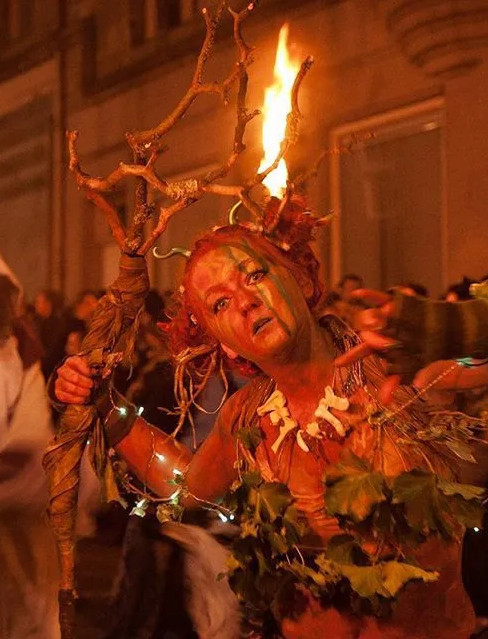
[Photo above: Samhain, courtesy of Beltane Fire Society]
Legends and myths about trees
Legendary tree deities (22)
Hyldemoer – 'the Elder Mother’, the guardian of the elder trees
“If you stand beneath an elder tree on midsummer eve you will see the King of the faeries and his entourage but be careful that you do not get swept away to faerieland.
The tree and the wood is greatly prized by the fae folk, so it must not be used to make mundane household objects, especially not a cradle or the baby will be pinched black and blue.
Do burn the wood or bring it into the house as this is very unlucky and will bring the devil in.
The Elder Mother guards the tree and although she is usually kind she can become dangerous, if her trees are harmed so you must always ask permission before cutting an elder tree.
To cut elder wood you must say, three times, ‘Elder Mother, please give me some wood, and I’ll give you some of mine when I grow into a tree (Ourd gal, give me some of thy wood, an oi will give some of moine, when oi grows inter a tree)’.”
Faeries and Folklore from the British Isles
The Elder Mother is thought to be the guardian of the elder trees, and it was said, until recent times in various parts of England and Scandinavia that to take wood from the elder tree one would have to ask the Elder Mother first, or else ill luck would befall the woodsman. The spirit is said to haunt or torment people who build from elder wood unless they ask permission first.
In Denmark, the Hyldemoer (“Elder-mother”) or Hyldequinde (“Elder-woman”) is a spirit like a wood-nymph or dryad that lives in the elder tree.
Other similar and related beliefs have been handed down in various cultures.
In Denmark, an elder twig put in the mouth was traditionally thought to drive out evil spirits and thus could cure toothache. Also in Denmark, on Midsummer's Eve, if you were to stand under an elder, you could see the Elf-king and his host. A similar tradition existed in Scotland where it was said to happen on All Hallows or Samhain.
In England, it was thought that the elder tree could never be hit by lightning and that carrying the twigs of an elder could protect their bearer from rheumatism. Farmers used to protect their animals from evil by placing a cross made from elder on their cow-sheds and barns.
In some Slavic countries, such as Russia, it is thought that the tree had the power to ward off evil. In Sicily, it was claimed to have the power to ward off snakes, and so on.
Every summer, our neighbourhood had an elder hedge with divine, full blossoms, but it was completely cut down to develop a residential site. These days, they spray the stumps with powerful chemicals to prevent regrowth.
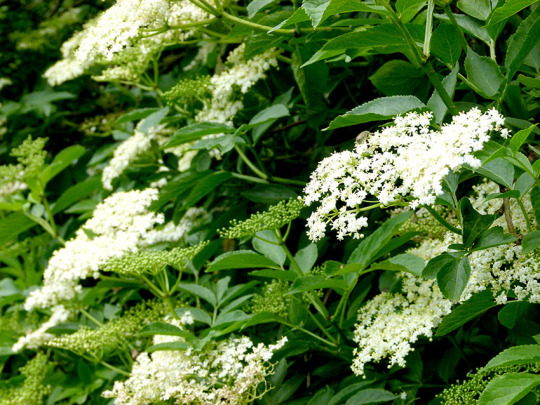
木にまつわる伝説・神話
伝説の樹木の神々 (22)
ヒルデモア-「エルダー・マザー」、ニワトコ (エルダー) の木の守り神
“真夏の夜、ニワトコの木の下に立つと、妖精の王とその一行を見ることができる。でも、妖精の国に流されないように気をつけて。
この木と木材は、妖精たちにとても珍重されている。だから、ありふれた家庭用品を作るのに使ってはいけない、特にゆりかごは厳禁だ。さもないと、赤ん坊は青黒く痣が付くまでつまんで痛めつけられる。薪を燃やしたり、家の中に持ち込んだりしてはいけない。これは非常に不吉で、悪魔がやってくるからだ。
エルダー・マザーは木を守っている。彼女は普段は優しいが、ニワトコの木に危害を加えると危険な存在になる。だから、ニワトコの木を切る前には、必ず許可を得ること。
『ニワトコのお母さま、私にあなたの薪をちょうだい。私が木に成長したら、私の薪も差し上げます』と、3回唱えなければならない。”
ブリテン諸島の妖精と民間伝承より
エルダー・マザーはニワトコ(エルダー)の木の守り神であると考えられており、イギリスやスカンジナビアの各地では最近まで、ニワトコの木から木材を取るにはまずエルダー・マザーに許可を得なければならず、さもなければ木こりに不運が降りかかると言われていた。その精霊は、まず許可を得なければ、ニワトコの木で建物を建てた人に取り憑いたり、苦しめたりすると言われている。
デンマークでは、ヒルデモア(「ニワトコの母」)またはヒルデキンデ(「ニワトコの女」)は、ニワトコ(エルダー)の木に住む木の妖精やドライアドのような精霊である。
このほかにも、さまざまな文化圏で似たような信仰が受け継がれている:
デンマークでは伝統的に、ニワトコの小枝を口に入れると悪霊が追い出され、歯痛が治ると考えられてきた。またデンマークでは、夏至祭の夜にニワトコの下に立つと、エルフの王とその群れが見えるとされていた。スコットランドにも同様の伝統があり、万聖節(All Hallows)またはサウィン祭(Samhain)に起こると言われていた。
英国では、ニワトコの木は雷に打たれることがなく、ニワトコの小枝を持っているとリューマチから身を守れると考えられていた。農家では、ニワトコで作った十字架を牛小屋や納屋に置くことで、家畜を悪魔から守っていた。
ロシアなどのスラブ諸国では、この木には魔除けの力があると考えられていた。シチリアでは、蛇を追い払う力があるとされていたなどなど…。
毎年夏になると、近所にニワトコの生け垣があり、神々しいほどの満開の花を咲かせていたが、宅地開発のために完全に切り倒されてしまった。最近では、再生を防止するため、切り株に強力な化学薬品を撒くらしい。
#trees#tree legend#tree myth#elder mother#hyldemoer#elder wood#elder trees#legend#folklore#mythology#all hallows#samhain#fairy#fairy tree#nature#art
100 notes
·
View notes
Text
Hyldemoer: el espíritu guardián de los árboles
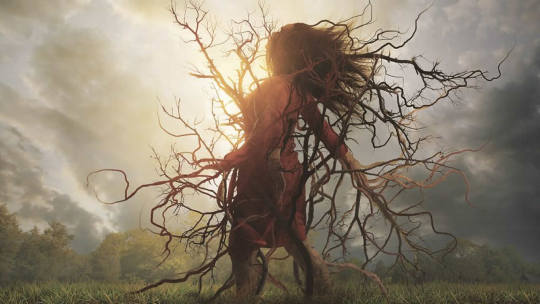
Hyldemoer: el espíritu guardián de los árboles
La mitología siempre ha sido relacionada con los dioses y los espíritus guardianes de la naturaleza. Así es como los nórdicos tienen la historia de Hyldemoer, el guardián de los árboles.
LEE MÁS
0 notes
Text
“The belief that a spirit inhabits this tree has survived even into relatively modern times. Specifically, a witch spirit was thought to inhabit the tree. There are numerous references to the belief that a witch lived in the elder tree and could shape shift back and forth from human to tree. An old name for this nature spirit was 'Hyldemoer,’ which means 'Elder Mother' in Danish. It was considered unlucky to cut the wood down for fire wood or building material in different parts of Europe. In England, it was said that burning elder wood would bring the devil into the house or that the person burning the wood would become bewitched. If you wanted to cut down the tree, you ask permission to escape possible ill fate. The appropriate way to ask was to say something like ‘Lady elder, give me some of thy wood, Then I will give thee some of mine, when I become a tree.' Another way to say it: 'Lady Ellhorn, give me of thy wood, and I will give thee of mine when it shall grow in the forest'. A Danish custom was to spit thrice before cutting or trimming an elder tree, to drive away evil beings. Hedge cutters would refuse to trim an elder tree for fear of being followed by bad luck. Spirits were believed to dwell in these hollow trees, specifically in the joints. This wood had a will of its own - if it was placed on a burning fire, it would cause it to go out; if it was used for furniture, it would bend and warp; if skewers were made from elder for roasting, it would turn the food bitter.
The old earth Gods of Prussia were believed to live had to under the elder tree and if offerings were made to it, little men would come, bringing grain and doing housework. If one stood under the elder tree on Midsummer's Eve, the Faerie king and his fellow faeries could be seen riding by. This mysterious tree was never touched after dark in the Fens in England. In Denmark, elder trees were believed to move around at night and could be found peering into windows of those sleeping. It was also said that faeties in the form of ancestors lived in the tree. If a cradle was made of elder wood, the baby sleeping in it would be either stolen by faeries or the Elder Mother. Or the baby would be pinched blacked and blue by the faeries. Elder was a tree associated with witchcraft from early times, from around 900 AD or before. In Ireland instead of an ash broomstick, witches rode on broomsticks made from elder wood. Country folks would sometimes refer to it as 'witch wood'. A name for the berries was 'Holda's Berries', which refers to the trees connection with Mother Holda or Hulda, an ancient winter death spirit from old Germanic culture.
There were other associations with elder and death. If an elder stick was planted over a grave and it grew, it was a sign that the deceased was happy in the afterlife. The old Jewish Cemetery in Prague was planted with elders. It was considered dangerous to sleep under an elder tree because the leaves apparently let out a fragrance that if inhaled, resulted in death. The flowers were known to attract snakes and it was reported that adder snakes slept in the dry roots of the clder tree. Polish people were known to bury their sorrows and sins under elder trees, so that chey passed into the underworld to where they belonged. Some sort of incantation was used to pass the energy into the elder tree, into the earth, then into the realms of the dead. An old saying goes: ‘Hawthorn blooms and elder flowers fill the house with evil powers.’ This is a connection to not only the white flowers of both plants, which in times past were highly unlucky to bring indoors as they were often used for funeral rites, but also to the supernatural energy associated with both trees.”
—
Under the Witching Tree:
A Folk Grimoire of Tree Lore and Practicum
‘The Black Earth Medicines of Autumn: Elder’
by Corrine Boyer
#under the witching tree#corrine Boyer#tree magic#tree lore#elder#elder mother#plant lore#witchcraft
115 notes
·
View notes
Photo

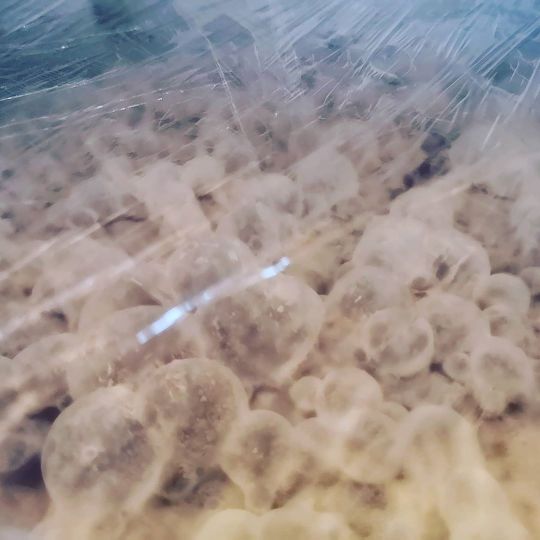

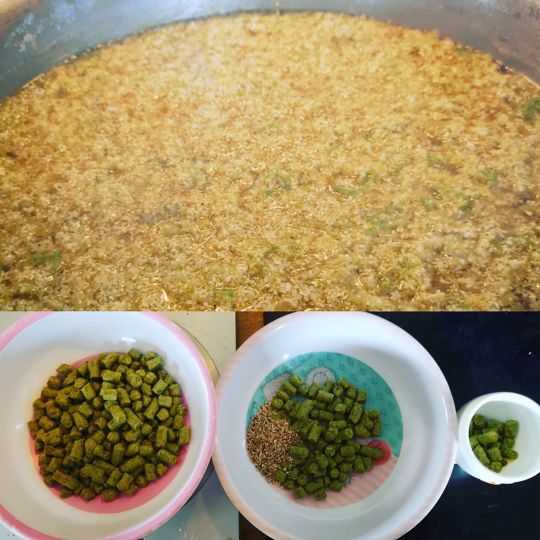
Brewday - Hyldemoer III (Belgian Golden Sour Version)
Here we go again! Split Brewday to do some more kettle souring. This time for a sour version of Hyldemoer, my 3rd brew of a seasonal Elderflower Belgian Ale. Previously I’d paired the Elderflower with Lime as it was a great combination, but this year I wanted to replace the sour citrus of the fruit with Lactobacillus Bevis sourness and more late addition Motueka hops.
After two poor efficiency brews I've altered my calculations just in case, I had to add a few extra bits to bulk up the recipe but it's still pretty similar to Hyldemoer II.
Mash is 75.6% Premier Pilsner, 8.1% Pale Wheat, 4.8% Torrified Wheat, 4.3% Aromatic Malt, 2% Acid Malt and 5.2% Belgian Candi Rocks to go into the Kettle.
Well I was bang on my numbers at 1.048 but that does mean 50% efficiency. I’m thinking it maybe too much acid malt. There was meant to be less in this beer but because I was short on torrified wheat it knocked the percent up. Will try 1% or less in my next brew to see if that makes a difference and if our water profile has changed recently which is affecting the mash.
Well it took about 36 hours for the Lacto just to get going and in the end after 4 days I was advised to up the temperature from 30c, so I pushed the Fermfridge to 36c and by the next morning I finally had a nice amount of bitterness.
Luckily I managed to get out between rain showers to collect some Elderflower as well to have it ready for the second boil. Late afternoon on a wet day wasn’t the best time to pick it, usually early on a sunny morning is, but with the poor weather forecast I'm glad I took my chance. It just meant a bit of sneezing as when I forked off 400g of flowers I gave each spray a sniff to make sure it wasn’t too fusty and had more of a floral lemon fresh smell. I covered the bowl over with clingfilm and put in my fridge, which did a really good job of keeping them fresh until I was ready with the beer.
Finally it was was time for the second boil to kill the Lacto off and get some Motueka hops and Elderflower in there. I did a 50 minute boil with 5g for bittering then 20g for 10 minutes and 55g for 5 minutes.
I was a bit low on volume so added another 200g of candi rocks and 145g of golden caster sugar dissolved in 4L water at flame out, along with the 400g of elderflower which I then steeped for 10 minutes before transferring and cooling to 26c to pitch Mangrove Jack's Belgian Ale Yeast. Revised OG now 1.051.
within 8 hours the airlock was bubbling away so I could relax a little. Possibly the longest split brewday so far, must remember to kettle sour at 36c next time.
1 note
·
View note
Text
THE ELDER-TREE MOTHER
A translation of Hans Christian Andersen’s “hyldemoer”
Once there was a little boy who went out and got his feet wet and caught a cold. Nobody could understand how it had happened because the weather was very dry.
His mother undressed him, put him to bed, and had the tea urn brought in to make him a good cup of elder tea, for that keeps one warm.
At the same time there came in the door the funny…
View On WordPress
0 notes
Photo

The elderberry tree is said to have a special connection to Frau Holle. Thus, the German childrens rhyme “Ringel, ringel Reihen, sind der Kinder dreien, sitzen unter Holderbusch, machen alle husch, husch husch” relates to Holle residing in the tree, which may steal the children. The Danish Folktale of the Hyldemoer tells of an old woman that resides in the tree of the elderberry (Thiele; Danmarks Folksagn;1843) A similar tale is recorded for northwestern Germany in the region of Niedersachsen, where the woman is known as Frau Ellhorn (Arnkiel;1702) and in Sweden, where she is known as Hyllefroa, or the ‘old gal’ in British Folklore. Frau Ellhorn was said to reside within the elderberry and referred to as a Goddess of ones homestead or house. Before the elderberry could be cut down, a prayer and a spell was said in order to ask Frau Ellhorn if the harvest would be allowed. (Ernst Goetzinger;2018). Indeed, the many “Frau-Holle-ponds” in Germany have been associated with women taking baths in the healing water to increase fertility. One such healing water is the spring of Amorsbrunn in Bavaria, where the pre-christian springwater cults have been adopted by the Church. The motif of the Stork, bringing human babies from the waters of Holle, be it her water wells that reach deep into the Underworld, the many ponds or water springs, might belong to such practice (Schrijnen;1977). When crafting a cradle for children made out of elderwood, Holle might steal or even eat the children (Thorpe; Northern Mythology;1851, Watts; Dictionary of Plant Lore;2007). This clearly resembles the tales of Perchta “opening the bellies of young children” or stealing them (Rumpf, M. (1976): 215). During the middle Ages, it was common to identify the Goddess of Venus with the Germanic Freya (Rudolf Simek;2003). Roman historian Cornelius Tacitus wrote in Germania of a Terra Mater of Germans; that the Suebi worshipped Isis (Tacitus, De origine et situ Germanorum, Übersetzung: Baumstark, 1876). It is thus likely that Frau Perchta had her own worshipping site in lower Bavaria, where the monastery Niederaltaich was built. https://www.instagram.com/p/ByAnWROng1V/?igshid=m9zpjxoie8hi
1 note
·
View note
Text
goddess of the dead.
Odin sympathized with Hel, so he granted her wish. Much more importantly, he also gave her the World of Niflheim, one of the Nine Worlds of Norse Mythology, to rule. He even went so far as to name that place after her, calling it Helheim or Hel. That was how Hel became the Goddess of the Dead.
In return for giving her Niflheim, Odin gave Hel certain responsibilities that she had to carry out in that realm. He charged her with caring for the souls of people who had died from sickness or old age, and for the souls of any other people whose deaths had not occurred through violence or in battle.
When warriors died in battle, their souls were split evenly between the Goddess Freyja and Odin. Freyja had the privilege of taking the first half of the souls of those warriors who had been slain in battle, while the remaining souls of the dead warriors belonged to Odin.
Hel settled into her Realm, and when the souls of the dead arrived there, it was she who judged them. It was also she who decided whether their souls were good or evil, and to what degree. Then, after Hel had made had her assessment, she gave each soul its just reward. Depending upon how they had been judged, the souls of the dead were settled into one of the nine levels of Helheim, which ranged from what might be seen as a form of heaven, all the way down to the dark horrors of Neostrand (Naströnd), the abode of punishment, where snakes constantly dropped venom upon the wicked, and which appeared, in many ways, to be quite similar to the concept of Hell, that the Christians have always appeared to be so fond of.
Hel was frequently thought of as a Dark Mother Goddess, and she was known by other names and titles including the Goddess of Death and the Afterlife, the Underground Earth Mother, the Ruler of the Realm of the Dead known as Helgardh, and Nefele, the Goddess of Shadows. She was also worshipped in Denmark, as the Hyldemoer, or Elder Mother.
Other stories exist regarding the Goddess Hel. One of them is an Icelandic creation myth, which described how in the beginning, all that existed was a great chasm known as Ginnungagap, which led to Hel's fiery womb of regeneration deep within the Earth. On one side of the chasm were fiery volcanoes, while on the other side there was nothing except for cold water and ice. It was for that reason that Hel became known as the Mountain Mother, who dwelled deep within the Earth where the fire and the ice meet.
While the Prose Eddas describe Hel as having been born with one side of her skeleton showing, a variety of other descriptions exist as well. Hel’s physical description is, to say the least, unique. Some descriptions claim that she was half-black and half-white, half-rotting, similar to that of a corpse, or half dead, and half alive, with a grim expression on her face, and a sinister appearance of gloom.
It is interesting to note that Hel's appearance is believed, by some, to be the origin of the masked harlequin, which has frequently appeared as a standard character in Commedia dell'Arte, with a black side of a face, and a white side. In fact, Hel's physical description, much like that of the harlequin mask, exhibits the duality that exists in the world, which is inherent to both life and death.
Legend tells us that Hel had an eye of fire, which could only see that which was true, thereby making it impossible for anyone to hide anything from her. Looking at this in a different light, Hel may actually have been challenging the world to find the courage necessary to look behind the mask that was her appearance, so they might see her as she truly was inside.
The Vikings, however, refused to do that. Instead, they looked upon Hel's appearance as something to be feared, and they believed that nothing good would come of her. Indeed, the Vikings looked upon Hel's home as a horrible place, similar to the Christians’ idea of Hell. But Niflheim was in no way similar to the Christian's burning place of fire and brimstone. Rather, it was seen as being icy cold and filled with slush, cold mud and snow.
The Prose Eddas described the nine-ringed realm of Hel, as a place where the inhabitants kept up a constant wail. It described her palace as a miserable place known as Damp with Sleet, where the walls had been built with human bones and worms. They also claimed that Hel ate with a knife and fork called Famine, from a plate known as Hunger, and that her two servants were both named Slow-Moving. Her bed was known as a Sickbed, and the stone at the entrance to her hall was referred to as Drop-to-Destruction.
The Prose Eddas continued, by saying that the entryway to Hel's Realm was guarded by the hellhound named Garm, and that before you could reach the threshold, you first had to travel the Helvig, or troublesome road to Hel, past the strange guardian maiden named Modhgudh.
While the Vikings may have feared her, which appears to be quite evident from the Eddas, the Dutch, Gauls and Germanic people who were known, in comparison to the Vikings, as the common people, viewed Hel in a somewhat less frightening manner. They saw her as a gentler and kinder form of death and transformation, and they did not believe that Helheim was a place of punishment at all.
They tended to see Hel as an earth mother deity known as Mother Holle, who consisted of pure nature. It was in that role that Hel was believed to have great maternal aspects, and that she was known to help people in their times of need. Hel, however, also had another side to her, and she was quite capable of becoming vengeful, whenever it became necessary, towards anyone who might attempt to interfere with, or stop, the progression of natural law.
Some myths describe Hel as a Dark Goddess, similar in some ways to the Hindu Goddess Kali, but more frequently then not, she was thought of as the Nehellenia, which means the Nether Moon. Numerous altars and artifacts relating to her worship have been found throughout Germany, and they date as far back as approximately the Second Century, C.E. Evidence also exists that her worship spread from Holland, all the way to New Zealand, as late as the Fourteenth Century, C.E., and it was in that particular aspect that Hel was believed to grant safe passage to seafarers.
When someone died, and entered Hel’s realm, it was almost impossible, for anyone on Earth to get them back. That was the subject of one of the most well known of the Norse myths: The Story of Baldur.
While the Vikings, who considered themselves to be strong and fearless, may have viewed Hel’s realm as a place of punishment and despair, others usually did not see it in that light, nor did they believe the Viking-influenced Eddas, and their dire description of Helheim. Unlike the Christian's Hell, which had been named after her, Hel's Realm was, in reality, nothing more then an Otherworld or Underworld, or a new and different plateau of existence. It was also a place of renewal, rather then a place of punishment and despair. The only ones to fear her were those who had good reason to. It was only they, who referred to her realm as Hell.
Hel has been described in a variety of different ways. There are those who claim that she is a destroyer; which in a way she actually is. However, when she does destroy something, she does so in it own proper time. That is why Hel can be looked upon, much like the Greek God Chronos, as a deity of time. As a Goddess of time, Hel takes on the role of entropy itself, and everything within the universe evolves towards a state of inert uniformity, which is a normal and completely natural event. When it comes right down to it, sooner or later everything will come to an end, which is exactly what should happen, as a part of its own cosmic destiny.
The Norse looked upon Hel as the supreme and inescapable ruler of fate and, much like the weaving Greek Fates, or the spinning and weaving Norns and Disir, not only did the Gods have no control over her, neither were they immune to her. That placed Hel in a very unique position.
Hel was not some form of death deity, who had specifically been created to rule over the Land of the Dead, nor did she gain her decaying visage when she became the ruler of that realm. She had simply been born with the bones on the left side of her body exposed. It had not been created purposely, nor had it been done out of contempt, or as a means of punishment. It simply happened. When Odin brought Hel to Asgaard, its inhabitants found themselves extremely uncomfortable because of her appearance. They were weak when they should have been strong, and they were, quite unfortunately, extremely insensitive to Hel’s feelings; so much so, that they made her feel alone and ostracized, which was, indeed, an extremely great tragedy.
It was for that reason that Odin gave Hel, Niflheim, to be her own and for her to rule over. By Odin giving her Niflheim, Hel finally found a place where she could feel comfortable, just being herself; a place where no one would see her as anything other then what she truly was. That was a very wise decision on Odin’s part, and it also showed, surprisingly enough, that good can occasionally come out of patriarchy, which has been known, all too often, to do the opposite; especially when it comes to placing women in positions of great power.
1 note
·
View note
Text
Hyldemoer
New Post has been published on https://allbestfonts.com/hyldemoer/
Hyldemoer
0 notes
Text
The Elder-Mother

The Elder Mother is an arboreal guardian figure in British, Germanic, and Scandinavian folklore, known by various names, such as the Danish Hyldemoer (“Elder Mother”) and the Lincolnshire names Old Lady or Old Girl. She is known as the protector of the Elder Trees, as well as one who guards the door to the Otherworld—realm of the Faerie and the Dead. As such, she is associated with some of the darker mysteries and magics, especially in relation to the cycles of life, death and rebirth.
Until relatively recently in Scandinavia and the UK, it was widely believed that if one harvested wood from an Elder Tree without permission from the Elder Mother, they would suffer misfortune at her hands. In order to gain her consent, the wood-cutter was required to address the Elder Mother by chanting or singing a particular promise: “Old girl, give me some of thy wood and I will give thee some of mine when I grow into a tree.” This simple vow refers to the potentiality for growth and renewal offered through death, as the decaying of the body gives way to the enrichment of the natural environment that serves as its final resting place.
Due to the high station of the Elder Mother, elder wood was also rarely ever burned, and such taboos can still be glimpsed in modern paganism, such as the line of the ‘Wiccan Rede’ which states, “Elder is the Lady’s tree, burn it not or cursed ye be.” Nor was it used to make furniture, and especially not child’s cradle, as it was believed to inflict sinister consequences. One such story of the Elder Mother’s retribution, following a disregard for her taboos, recounts the mother of a sick child, saying : “It were all along of my maister’s thick ‘ead. It were in this ‘ow’t’ rocker comed off t’cradle, and he hadn’t no more gumption than to mak’ a new ‘un out on illerwood without axing the Old Lady’s leave, and in course she didn’t like that, and she came and pinched the wean that outrageous he were a’most black in t’ face; but I bashed un off, and putten an eshen on, and the wean is gallus as owt agin.” (Translating, approximately, as: “It was all my husband’s fault. One of the rockers came off the baby’s cradle, and he was reckless enough to make a new one out of elder wood without asking the Old Lady’s permission. Of course, she didn’t like that, and so she pinched the baby until his face was bruised. But I replaced it with an Ash wood rocker, and the baby is good a new again.”)
Bearing an intimate connection to the Otherworld, Elder is widely considered a Faerie Tree. In Denmark, it was said that if a person stood beneath an Elder tree, wearing a crown of Elder on May Eve, they would be able to commune with the Other Realm and see the Faerie and the spirits of the Dead. According to a similar, Scottish tradition, it was said that if you stood beneath an Elder on the eve of Samhain, you would be able to see the Elven Monarchs and their hosts of Elves. However, while the Elder is intimately linked to the Faerie Faith, it is also closely connected to the lore of witches.
A tale from Northamptonshire tells of a man who cut a switch from the branch of an Elder, only to see that the tree was oozing blood. Later that day, upon meeting the local witch, he notices that her arm is newly dressed with a bloody bandage.
Another tale, from Somerset, describes the Elder Mother as a malevolent witch who is seen by a farmer, in the form of an Elder Tree, milking his cows. The farmer shoots a silver bullet at the witch, but misses, and is forced back into his home. However, the old grandmother of the household is able to save them all by taking a burning ember from the hearth with a shovel, and throwing it at the Elder Tree, which burns to ashes.
Yet another story casts the Elder Mother, not only as an Arboreal Witch, but as the morally ambiguous heroine of the tale. She is credited in the tale with rescuing Britain from being conquered by a foreign king and his cavalry. This also serves as an origin myth for how the Rollright Stones, rest along the Oxfordshire / Warwickshire border, came to be. As the king and his knights made their way to Long Compton, they came across the witch, who told the king:
“Seven long strides thou shalt take, And if Long Compton thou shalt see, King of England thou shalt be.”
The king went onwards though, saying:
“Stick, stock, stone, As King of England I shall be known.”
However, when the King’s made his seventh stride, a hill rose up before him, preventing him from seeing Long Compton. The witch spoke to the king and his men once again, saying:
“As Long Compton thou canst not see, King of England thou shalt not be, Rise up stick and stand still stone, For King of England thou shalt be none;, Thou and thy men hoar stones shall be, And I myself an Eldern tree.”
And so, the king and his knights were turned to stone and the witch turned herself into an Elder Tree.
With all of these connections to witchcraft and danger, however, the elder tree has also long been known as a protector against evil forces, with multiple European traditions holding that Elder can be powerfully employed to ward against witchcraft and malicious spirits. These beliefs were particularly upheld during the Medieval Period. The country folk of old Britain, for instance, sometimes took to stringing leaves of Elder and tying them to their doors and windows, due to the belief that no malefic witch could enter a house protected in this way. This belief also extended to placing fallen bows of the wood in the doorways of one’s home and barn to turn away bad influences, which even included things like flies. Similarly, garlands of dried Elder leaves were sometimes worn for protection by people and their animals, or were scattered over a person or object to invoke a blessing before being scattered north, south, east and west to dismiss ill fortune. Twigs of Elder gathered at Midsummer’s Eve were, likewise, carried as safeguards against harmful or mischievous wights.
The protection this tree offered was not only limited to the denizens of the living world, though. Elder leaves were sometimes ritually strewn along grave beds to help protect the souls of the deceased, and in some areas, there was even a custom of planting an Elder which had been trimmed into the form of a cross on newly dug graves. It was said that this would help to assure the harmonious transition of dead person’s spirit, and what’s more, there existed a traditional belief that, if one of these Elder crosses blossomed, it was a sign that the soul of the interred was at peace.
All of these stories and beliefs come together to form a unique and powerful cultural tapestry of the figure known as Elder Mother. Between her multifaceted nature as a Tutelary Goddess, a Faery Queen, and a Witching Spirit, I feel confident that the she will remain a significant figure of the Craft for generations to come.
Art Credit: Arthur Szyk for 'Andersen's Fairy Tales' by Hans Christian Andersen
#magic#witchcraft#witch#traditional withcraft#poison path#herbcraft#nature magic#faerie folk#faerie faith#faerie#faerie magic#elder mother#art credit: arthur szyk
1K notes
·
View notes
Photo
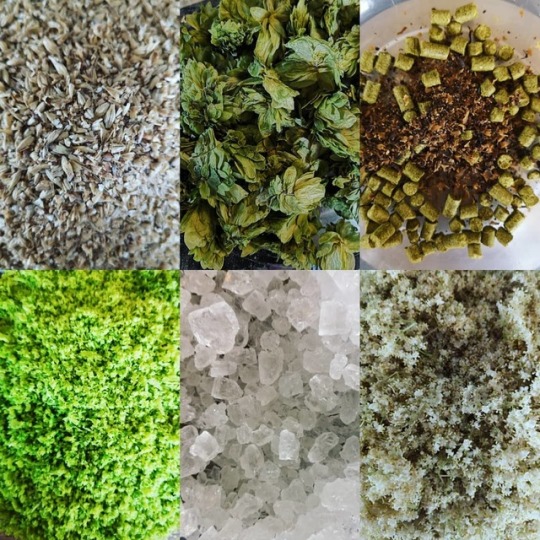
Brewday - Elderflower & Lime Belgian Blonde (Hyldemoer II)
It’s that time of the season again, Elderflower is exploding all over the land and if you’re a homebrewer you’d be foolish not to take advantage of this wonderful hedgerow bounty.
Last year I made a Pale Ale with Elderflower and Lime called Hyldemoer, I find it best to pair the very floral nature of the Elderflower with a complimentary flavour, Rhubarb is another one that goes well but the Elderflower and Lime beer I made last year went down a storm, I even had non-beer drinkers drinking it. So I decided that I would stick to the basic concept but alter the base beer. Now I recently tried Duvel’s Citra Triple Hopped beer and it was a revelation, why hadn’t I thought of making more adventurous Belgian beers like this before?
This was the perfect time to try it out so I put together a malt bill of 80% Pilsner, 5.9% Aromatic Malt, 4.7% Torrified Wheat, 3.5% Acid Malt & 5.9% Clear Candi Sugar. Mash at 66c with sparge at 68 and went with 15g Fuggles for bittering then 20g Motueka for 15 minutes with everything going in for the final 5 minutes, that being 30g Motueka, 500g of Elderflower & the juice and peel of 10 limes! I used 12 limes last year but these were much bigger and I got quite a lot of juice, hence me upping my elderflower addition from 345g last year to 500g this, trying to balance those two flavours.
I went with the New Zealand hop Motueka for it’s citrus flavours, especially as its associated with lime. Trying to pair off the floral lemon citrus of the elderflower with actual limes and the hops. The fuggles are just for bittering really.
I processed the Elderflower like usual which is forking the flowers off with as little stalks as possible. My only problem was that it’s actually a little bit early for Elderflower in the North at the moment, but with last weekend been my only free one for brewing for a couple of weeks I had to go on the hunt for some earlier bushes than the one I usually forage from. Not the most glamorous foraging session but needs must as I went out in the drizzle and rain down the main road where I'd spied some on the way home from work. The dog was not happy about this, we got rather soggy, lol. But I got more than enough to use, I just had to lay it out on a towel overnight so that it wasn’t soaked with rain water.
Everything came together well although I had a bit more boil off than I planned so I liquored back a bit and added a little more candi sugar. This meant I ended up at 1.047, just two points over target, so should leave me around 5% depending on how well the Mangrove Jack's Belgian Ale Yeast attenuates. I know 5% is a bit low for a Belgian Blonde but this isn’t your traditional Belgian beer. I wanted it a little more sessionable. It’s also my first time trying a dried yeast for a Belgian beer, it kicked off fermenting quite gently so fingers crossed that a dried yeast can live up to the liquid ones.
5 notes
·
View notes
Text
Ginger Cinnamon Elderberry Syrup ~ Immune System Support
The elder tree is known to many herbalists as a sacred tree. While we’re sure it has its own stories to tell, there’s already an abundance of recorded folklore. In Scandinavian and Danish myths, this tree was thought to be guarded by a forest spirit named Hyldemoer, also known as Elder Mother. Before anything was taken from the tree, it was believed that one must say a certain charm for her…
View On WordPress
1 note
·
View note
Text
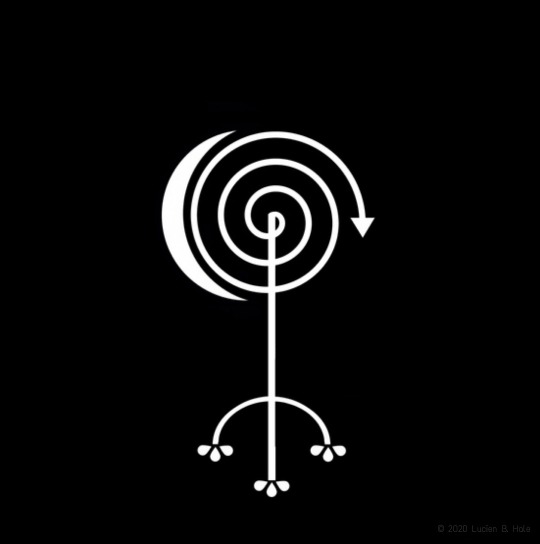
Sign of The Elder-Mother:
The Sylvan Gate
—
This is a sigil I created within my practice for the purpose of convoking and conducting the influence of the Elder Tree Mother.
The Elder Mother is an arboreal guardian figure in Celtic, Tsutonic, and Scandinavian folklore, known by various names, such as the Danish Hyldemoer ("Elder Mother") and the Lincolnshire names Old Lady or Old Girl. She is known as the protector of the Elder Trees, as well as the one who guards the door to the Otherworld—realm of the Faerie and/or the Dead. As such, she is associated with some of the darker mysteries and magics, especially in relation to the cycles of life, death and rebirth.
The Sylvan Gate, Sign of the Elder Mother, channels the primordial power of the Elder Tree Mother and ratifies it on thie phsycial plane. I use this sigil when working with the genii of The Elders, for one purpose or another, but I also use it any time I see fit to work with the Elder Mother herself. As such, it is appropriate and useful when in it comes to any magic planted firmly in communion with the Otherworld, the Faerie Folk, and/or the Dead. Self-enchantments for the second-sight, calling upon the Mighty Dead, and pacts with Wild Wights are several examples of workings that might benefit from the potency of the Elder Mother.
#magic#witchcraft#witch#traditional withcraft#faerie folk#faerie faith#faerie magic#otherworld#elder mother#sigil#sigil magic#sigilwork#wending way
466 notes
·
View notes
Photo
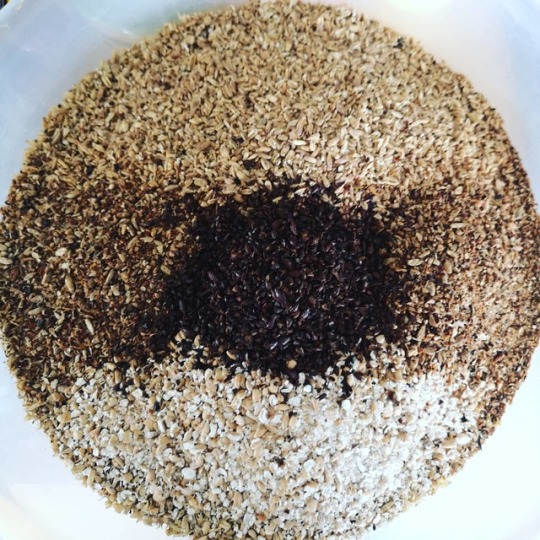

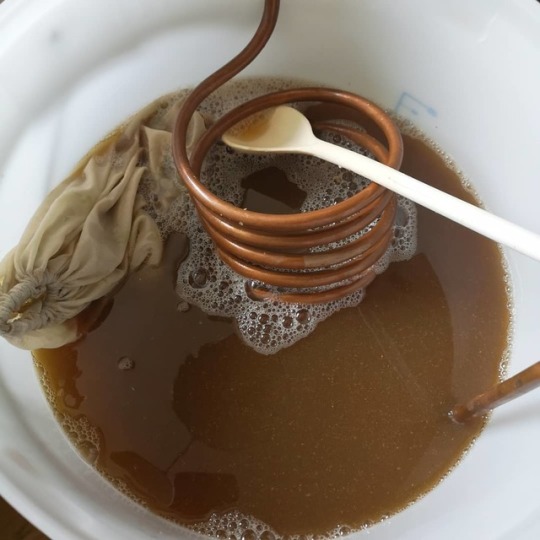
Brewday - English Bitter (Wassail!)
I suddenly realised last week that I had some spare time this weekend and if I bottled Hyldemoer would have Fridge space to get my next planned brew on. But once taking stock of all the beer I’d have ready for summer BBQ season it dawned on me that most of my beers had weird additions, fruit, flowers or wild fermentation, etc, and were all over 5% so I thought I could do with a simple beer for any visitors that weren’t so into their craft. I had just enough grain and hops kicking about that all I had to do was order some SafAle04 yeast and we were off.
So another shot at making a beer below 4%, aiming for 3. 7%, going for a pretty simple English Bitter using up some bits. The grain bill was 80.5% Golden Promise, 7.9% Golden Naked Oats, 5.3% Pilsner, 2.9% Torrified Wheat, 2.6% Crystal Rye and 0.8% Black Malt. I mashed at 66c and sparged at 70c.
For the boil it was 20g Fuggles for 60 mins with another 10g for the final 10 minutes along with 15g Tettnang & 15g Whitbread Goldings. Then I tried out some whilpooling which I've not done before. Inspired by our Brewday at Brew York, I didn't realise you didn't need fancy machinery to whirlpool, lol. Just a fancy way to say stirring it after the boil. From that brewday and further research it would appear that some of the hop oils can evaporate above 60c so once the beer was cooling below that I added 21g Bramling Cross and 23g Whitbread Goldings for 20 minutes. It's kind of an easier way to get some of those dry hop flavours without having to dry hop, apparently. Anyway hoping for a big fruity hop taste from those traditional English Hops that are never used in large enough amounts to get their wonderful earthy flavours through in most commercial beers.
Unfortunately my efficiency this time was up to 70% so my OG was 1.040, I’ve once again failed to brew a beer below 4%, lol. Never mind. SafeAle04 pitched, fermentation set to 19c and now I need to worry about getting more bottles as I’m running low. I have 2 weeks to sort that, lol.
Oh and I came up with a name early, as this a good old English quaffable beer (I hope) I’ve gone with Wassail! which is an old Anglo Saxon toast. I thought about using the Viking “Skol”, but just kept thinking about that terrible lager from the depths of time, lol.
3 notes
·
View notes
Photo
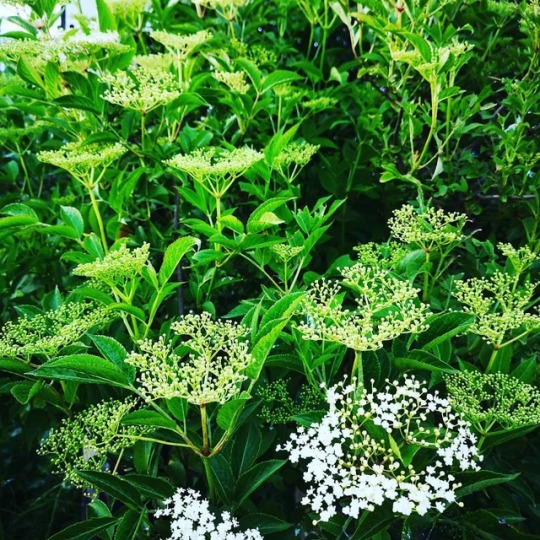
Elderflower Season is Upon Us!
Time to reorganise the Brew Schedule again, you have to think on the fly when it comes to foraging. My favourite Elderflower out in the Cawood countryside is looking ready to burst, another week or so should do it and I don't want to miss out of the freshest flowers. Hyldemoer was so popular last year I'm going to go with the Elderflower and Lime combination again but this time instead of just a simple pale ale it'll be a Belgian Blonde version with Motueka hops. All the ingredients have arrived now I just need to keep an eye on the Elderflower and hope I can coincide a free day to brew with the best fresh flowers.
1 note
·
View note